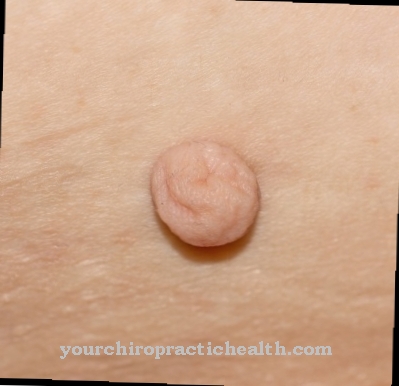There are pathological, congenital and artificial ones Fistulas. A fistula is always a passage that allows fluid to flow through. It often forms when there is inflammation to drain pus. A pathological fistula usually has to be treated surgically.
What is a fistula?

A fistula is a tubular connection between two hollow organs or between a cavity in the body and the surface of the body. There are different types of fistulas. The artificial fistula, such as the feeding fistula, is surgically created to bypass part of the digestive tract and to feed the body with the food with a tube.
The congenital fistula is caused by prenatal developmental disorders. Connections remain that should actually close before birth. In the case of the urachus fistula (bladder-umbilical fistula), a connection remains between the bladder and the navel;
The pathological fistula develops during inflammatory processes either when an abscess (encapsulated collection of pus) has formed or when a purulent inflammation has developed in an existing body cavity. Pathological fistulas often occur with tooth inflammation in the mouth and in the anal area with the intestinal disease Crohn's disease.
causes
The cause of the pathological fistula is a purulent inflammation, which is usually triggered by bacteria. Pus develops in a closed body cavity or a newly formed closed tissue cavity (abscess) forms due to the inflammation.
Pus is a product that arises during the defense reaction against germs. Since the pus cannot drain and the pressure from the pus production increases, the body forms a tubular duct to drain the secretion.
The fistula either runs to a cavity in the body or to the surface of the body. There it becomes visible as a small hole from which pus emerges. The cause of a congenital fistula is a disorder in prenatal development.
Diseases with this symptom
- Arteriovenous_fistula
- Crohn's disease
- Anal fistula
Diagnosis & course
A fistula that runs to the surface of the body usually shows up as a small pimple filled with pus. Those affected feel pain and a feeling of pressure at the site of the inflammation. The tissue over the inflammation focus is swollen and the pain spreads to the surrounding area.
Sometimes the skin over the fistula is also itchy. Anal fistulas are initially only noticeable through oozing. The more secretion that accumulates, the more clearly the pressure and swelling can be determined. Most of the time, some of the pus empties when you press on the swelling. But after a while, the fistula or the underlying abscess fills up again.
Internal fistulas, i.e. pathological passages between two organs, often lead to fever and fatigue. The doctor will use the symptoms to determine that there may be a fistula. However, other diseases with similar symptoms, such as boils, must always be excluded. Additional information can be obtained with the help of ultrasound or X-rays. To do this, the doctor fills the fistula with a contrast medium to make its course visible.
When should you go to the doctor?
A pathological fistula forms when there is inflammation so that the fluid that is formed, generally pus, can drain away. The fistula is a tubular connection that is either between two hollow organs or otherwise between a body cavity and the body surface. In addition to the pathological fistula, there is also the congenital fistula and an artificially created fistula. This section deals with the pathological fistula that needs urgent treatment by a doctor.
The cause of the formation of a fistula is often the purulent inflammation of a naturally existing body cavity. Abscesses can also lead to the formation of a fistula, as well as tooth inflammation and intestinal diseases such as Crohn's disease. The purulent inflammation underlying the fistula is primarily triggered by bacteria. Pus is always a potential hazard for the body. Therefore, a fistula should definitely be treated by a doctor.
Since medical laypeople often cannot recognize the symptoms of a fistula at all, it should be said here that, as a precaution, a doctor should be consulted even in the case of disturbances of well-being that initially appear banal. A fistula connected to the body surface often initially manifests itself as an apparent pus pimple. Itching or oozing can also indicate a fistula. If you are tired or have a fever, it is time to see a doctor. The fistula therapy is diverse.
Doctors & therapists in your area
Treatment & Therapy
In order to remove a fistula, an operation usually has to be performed. In the case of fistulas that have formed from abscesses or inflamed hollow organs, the inflammation is treated with antibiotics. Abscesses must be opened and drained surgically. Larger abscesses are left open for some time, that is, a drain (drainage tube) is placed on the surface of the body so that any newly formed pus and wound water can drain off.
Sometimes a tamponade soaked in antibiotics is placed in the abscess to speed it up. This is then removed again after a day or two. Once the inflammation has healed, the fistula will recede by itself. In the case of the anal fistula, a thread drainage is placed in the fistula duct. This often has to remain in place for weeks to months so that the fistula can gradually dry out and heal.
For congenital fistulas, treatment is based on the symptoms they cause. A bladder and umbilical fistula must be closed surgically because urine is leaking from the umbilicus. A congenital ear fistula, on the other hand, often remains without symptoms and usually does not need to be treated.
Outlook & forecast
In most cases, surgery is needed to remove the fistula. As a rule, there are no further compilations or complaints, so that the overall course of the disease is positive.
Often the fistulas are filled with pus and can burst. In the case of unsanitary treatment, inflammations and infections can develop as a result. Fistulas in the anal area are very uncomfortable for the patient. These often itch and swell, so that the quality of life of the person affected is greatly reduced. Most patients also suffer from a fever and a general feeling of illness. If the fistula occurs, a doctor must be consulted. Treatment solely with home means is not recommended.
Treatment by the doctor usually takes place with the help of antibiotics and leads to success relatively quickly. In the case of abscesses, these are emptied. After the inflammation has healed, the fistulas usually recede on their own, so that no further symptoms arise for the patient. If the fistula is already congenital, no treatment is usually necessary. This also applies to congenital fistulas in the area of the ear.
prevention
A fistula that arises from an inflammation can be prevented by treating the inflammation early. You avoid the formation of pus and thereby prevent the development of a fistula.
You can do that yourself
As a rule, a fistula must be surgically removed. However, there are numerous options available to prevent a fistula or to alleviate the symptoms. A balanced diet is extremely important. Those affected should avoid spicy dishes, ready meals and meals containing fat. The diet should be supplemented with fiber and cereals. They soften stool and make it easier to empty your bowels.
To prevent a fistula, sufferers should drink plenty of water. The recommended amount is around two liters per day. Those affected should avoid alcohol and soda. Alternatively, fruit juices are excellent. They will help prevent blockages that put force on the fistula. The use of a pillow is also advisable. A pillow is particularly suitable for those affected who have to sit for numerous hours.This avoids strong pressure on the back, bottom and legs. In addition, absorbent pads are useful. So those affected do not have to worry about blood, pus and wound secretion stains. Alternatively, diapers can also be used. However, these are thicker and stigmatized.
Personal hygiene is of enormous importance. Those affected should clean themselves after every use of the toilet. It is important to avoid bacteria that linger on the skin. This is the only way to avoid infection. Affected people can temporarily use damp cloths when they are out and about.
























.jpg)



